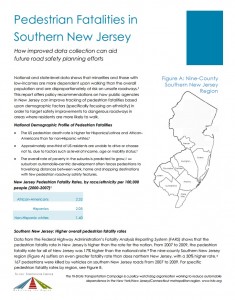
can improve tracking of pedestrian fatalities based upon demographic factors in order to target safety improvements to dangerous roadways.
A new Tri-State analysis shows that if you are a pedestrian in South Jersey, you are at greater risk of getting killed by a vehicle than pedestrians in northern New Jersey—or the nation as a whole. Coupled with national data that shows that minorities tend to walk more than the overall population, there could be startling, and useful, deductions made at the local level—if the right data were available.
The new report, Pedestrian Fatalities in Southern New Jersey, shows how the unavailability of racial and ethnic data in pedestrian fatality reporting at the local level makes it difficult to determine the pedestrian fatality rates of these population groups. Without this information, it is difficult to target safety campaigns and infrastructure improvements toward populations that may experience higher pedestrian fatality rates.
Transportation for America’s 2011 report Dangerous by Design notes that minorities tend to walk more than the overall population and are at greater risk of being killed on unsafe roadways than non-Hispanic whites. Their report showed that this trend held true in New Jersey for the period between 2000 and 2007. But, it’s a challenge to drill down to the risk at a regional or local level because racial and ethnic data is not uniformly reported in pedestrian fatality databases.
TSTC’s report looked into a nine-county South Jersey region (Mercer, Burlington, Ocean, Gloucester, Camden, Salem, Atlantic, Cumberland and Cape May counties), which had a 30 percent higher pedestrian fatality rate than the northern portion of the state for the period between 2007 and 2009, and found that reliable demographic data, other than gender and age, is unavailable at this scale.
Tracking this data can help public agencies target safety improvements to dangerous roadways in areas where residents are more likely to walk. For instance, knowing the age (which is uniformly reported) of pedestrians who have been killed by cars can help build support for a Safe Routes to Schools or Safe Routes for Seniors program.
While location, gender and age for all pedestrian fatalities are reported by both the National Highway Safety Administration’s Fatality Analysis Reporting System (FARS) and the Centers for Disease Control and Prevention’s Web-based Injury Statistics Query and Reporting System (WISQARS), FARS race/ethnicity data is incomplete at the state level and WISQARS race/ethnicity data is unavailable at the sub-state level (and is also incomplete after 2007 due to new privacy measures).
Capturing as much data as possible makes it easier for agencies, advocacy groups, and community members to develop safety programs and infrastructure improvements targeted towards those populations currently suffering from disproportionately high pedestrian fatality rates. In the absence of more comprehensive reporting, some populations will disproportionately remain at risk.

[…] TSTC: Data on Race and Ethnicity Would Help Mitigate Pedestrian Fatalities (MTR) […]
[…] on the Network today: Mobilizing the Region shares a new study that compared pedestrian fatality rates in north and south Jersey and finds some […]
There was a pedestrian fatality on NJ Rte 70 eastbound in Cherry Hill NJ about three days ago. Phila Inquirer report was that the driver was speeding excessively. Time was about 8am, daylight.
Bill Vigrass, Phila Inquirer subscriber.
Tracking the profile of the drivers, vehicles, actions, and roadway type would be more productive. Then you could develope campaigns targeting them, not the victims.